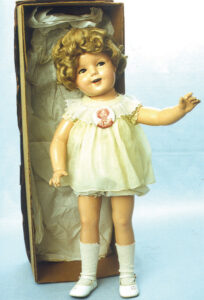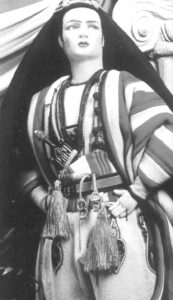 By Robert Reed
By Robert Reed Delightful dolls have paid tribute to the real-life people of prominence for more than a century.
From war heroes to movie stars and from presidents to quintuplet children those of fame have been further immortalized with a doll in their image. Typically doll makers have sought to capitalize on the popularity of genuine celebrities, and usually that effort turned out to be very worthwhile.
As early as the 1850s certain China head dolls were given celebrity names even though they merely resembled someone famous. A good example was the Jenny Lind doll which looked very much like the much heralded Swedish signer who made concert tours to the United States during that decade.
By the 1860s other China head dolls were identified with First Lady Mary Todd Lincoln, Queen Victoria, singer Adelina Patti, and many others. In reality the facial features and hairstyles of the dolls did look somewhat like photographs of these famous women, but they were certainly not official designs.
In 1869 a remarkable likeness of General U.S. Grant was sold at the Paris International Exposition. The 14-inch poured wax doll with highly detailed facial features wore a black wool suit with shirt and vest. One of the dolls, purchased at the event by an American family, was sold at Theriault’s famed doll auction in 1996.
The Spanish-American War of 1898 gave military leaders a renewed popularity, and some of them such as Admiral George Dewey and Admiral W. S. Schey were the subject of dolls. Some of the finer examples had doll heads produced by Germany’s distinguished Cuno & Otto Dressel. At times some such dolls were assembled and distributed by Simon and Halbig in Germany.
Celebrity dolls became a product of American doll makers early in the 20th century with Ideal Novelty and Toy Company clearly becoming one the leaders in that effort.
For decades Ideal “was a forerunner in using licenses of famous celebrities or fictional characters for their dolls,” noted Judith Izen in the second edition of Collector’s Guide to Ideal Dolls. One of Ideal’s earliest celebrity dolls came in 1911 in the image of famous baseball player Ty Cobb. The doll had a composition head and hands, cloth body, and nifty wool uniform.
 Early in the 1920s the Horsman Doll Company produced a composition doll named after child motion picture star Jackie Coogan. It also had a composition head and cloth body. Ultimately, however, the most significant celebrity doll of that era would be a non-doll in the image of actress Mary Pickford.
Early in the 1920s the Horsman Doll Company produced a composition doll named after child motion picture star Jackie Coogan. It also had a composition head and cloth body. Ultimately, however, the most significant celebrity doll of that era would be a non-doll in the image of actress Mary Pickford. Exacting research by Theriault’s shows that the woman on the silver screen had directed her agent to meet with Germany’s Simon and Halbig firm to come up with a suitable Mary Pickford doll. A lovely head for the doll was sculpted by Lilly Baitz and there were even specifications for clothing and hair.
Despite all the time and effort involved, the doll was never mass-produced. One of the few known existing prototypes of the Pickford doll was auctioned by Theriault’s in recent years. In excellent condition, it came with an assortment of documents and promotional materials.
There is no doubt that the greatest celebrity doll of the 20th century was issued in behalf of child movie star Shirley Temple.
The fabled Shirley Temple dolls alone brought in more than six million dollars during the 1930s making Ideal one of the more profitable toy companies in the United States. There were different versions of the doll, wearing different outfits. One of the most distinctive was the 18-inch composition issue with sailor suit. In addition to Ideal’s variety, there were also several look-a-like imitations marketed by rival firms during that period.
In 1936 the Curtis Publishing Company made a promotional doll out of a Shirley Temple issue. She was offered “dressed in a fluffy party dress like Shirley’s own” as a premium for subscriptions to Ladies’ Home Companion magazine.
Other notable Ideal celebrity dolls of the 1930s and slightly beyond included movie starlets Deanna Durbin and Judy Garland.
Madam Alexander also provided some significant celebrity dolls in that same time span including entertainer Jane Withers and ice skating champion Sonja Henie. The Henie doll was especially striking wearing a black velvet skating costume and gold skates.
However the major celebrity contribution of the Madam Alexander firm during the 1930s were dolls which celebrated the birth of the famed Dionne quintuplets. There were various issues including one set which provided figures of the doctor and nurse as well as the five infants.
Interestingly some of the early composition Dionne quint dolls were designed by Bernard Lipfert, the very same person who designed the early Shirley Temple dolls. Initially the quint dolls retailed at $1.98 in department stores and other outlets, generally much less than other celebrity dolls of that decade.
During the 1940s, in the midest of World War II, the Freundlich Novelty Company issued a General Douglas MacArthur portrait doll. The composition figures had painted featured and wore a military cap molded to the head. Terri Lee Inc. went with western movie star Gene Autry in 1949. The plastic Autry doll wore an entire cowboy outfit including belt, boots, and cowboy hat.
In 1950 the Allied Grand Doll Company produced a 13 inch composition doll honoring baseball great Jackie Robinson. The finely made doll in a Brooklyn Dodger uniform was billed as “the promotional hit of the year” by the manufacturer.
Other 1950s celebrity dolls included Juro Novelty Company’s Dick Clark the star of American Bandstand, Ideal’s Mary Hartline of Super Circus television fame, and Ike and Mamie Eisenhower from Martha Thompson Portrait Dolls. Meanwhile, Nancy Ann Storybook Dolls issued hard plastic Dale Evans and Roy Rogers dolls in full western dress including guns and holsters.
Ideal was back in the celebrity scene during the 1960s with several sections including singing artist Diana Ross. “She’s the luscious Supreme and she’s making the scene big,” said advertisements, “She’s Ideal’s Diana Ross.” In England, Primrose released a doll in the image of still another singing artist, Barbara Streisand.
Mattel moved into a leadership role with their own choice of celebrity dolls in the 1970s. Drawing from popular television shows the company issued dolls in the form of Donny and Marie Osmond plus Charlie’s Angels stars Cheryl Ladd and Kate Jackson. Other Mattel offerings in that decade included singer Debby Boone and actress Kristy McNichol.
Elsewhere in the ‘70s, Madam Alexander introduced a series of president’s wives dolls which included Dolly Madison and Martha Washington. And the Mego Corporation’s starring lineup included a new Diana Ross doll, Charlie’s Angels Jacyln Smith, and Suzanne Somers.
Some celebrity issues even survived into the 1980’s. Effanbee Doll Company offered up Humphrey Bogart and Eleanor Roosevelt. Mattel honored hockey super star Wayne Gretzky, and enduring Ideal provided Bud Abbot and Lou Costello celebrity dolls wearing baseball uniforms.
Today many of the celebrity dolls of the past are highly collectible, and some even extend to the historic and rare range among collectors.















Follow Us